Understanding Eosinophilic Enteropathy: Insights and Management


Intro
Eosinophilic enteropathy represents a collection of gastrointestinal disorders distinguished by the prominent infiltration of eosinophils within the gastrointestinal tract. This condition presents a unique clinical challenge due to its complex nature and variable manifestations. As eosinophils are a type of white blood cell involved in immune responses, their increased presence in the gastrointestinal system indicates an underlying issue that requires careful consideration.
The multifaceted nature of eosinophilic enteropathy necessitates a thorough exploration of its causes, symptoms, diagnostic methods, and treatment strategies. Often, this disorder is associated not only with gastrointestinal symptoms but also with other atopic conditions like asthma and allergic rhinitis. Therefore, a comprehensive understanding of eosinophilic enteropathy is crucial for healthcare professionals. By exploring this disorder's pathophysiology and clinical presentation, practitioners can better serve patients who struggle with it.
In the subsequent sections, we will delve deeper into the research surrounding eosinophilic enteropathy, covering its key findings, methodologies, and the importance of this work in advancing our understanding of gastrointestinal disorders.
Prologue to Eosinophilic Enteropathy
Eosinophilic enteropathy encompasses a broad range of gastrointestinal disorders characterized principally by the infiltration of eosinophils in the gastrointestinal tract. Understanding this condition is crucial for both medical professionals and patients. Through a detailed examination, we can appreciate the complexity of eosinophilic enteropathy, its implications on overall health, and the importance of accurate diagnosis and management strategies.
Definition and Classification
Eosinophilic enteropathy refers to a group of disorders where eosinophilic infiltration occurs within the gastrointestinal tract. This infiltration can lead to significant gastrointestinal inflammation, resulting in various symptoms like abdominal pain, diarrhea, and malabsorption. Classification of eosinophilic enteropathy can vary. Conditions may be classified based on the severity of the eosinophilic infiltration and the specific parts of the gastrointestinal tract affected. Generally, there are three recognized types: eosinophilic esophagitis, eosinophilic gastritis, and eosinophilic colitis. Each type affects different regions and has distinct symptoms, making it essential for clinicians to accurately assess symptoms and tailor treatments based on the classification.
Historical Context
The understanding of eosinophilic disorders has evolved considerably over the years. Early descriptions of eosinophilic infiltration in the gastrointestinal tract can be traced back to the mid-20th century but often lacked a clear clinical diagnosis or classification. It was not until the late 1990s and early 2000s that eosinophilic enteropathy began to gain recognition as a distinct clinical entity. This recognition coincided with advances in diagnostic techniques, including endoscopic evaluation and histological examination. The growing body of research regarding eosinophils' role in various inflammatory processes further solidified the need for awareness of eosinophilic enteropathy. As new therapies emerge and research progresses, it remains essential for healthcare providers to remain updated on the definitions, classifications, and historical context of eosinophilic enteropathy to improve patient outcomes.
Pathophysiology of Eosinophilic Enteropathy
The pathophysiology of eosinophilic enteropathy is critical for understanding the mechanisms that underlie this complex disorder. This section delves into the biology of eosinophils, how they become activated, and the resultant inflammation and tissue damage they cause. Grasping these concepts is essential for healthcare professionals as they navigate the diagnostic and treatment landscape of eosinophilic enteropathy.
Eosinophil Biology
Eosinophils are a type of white blood cell that plays a significant role in the body’s immune response. Their primary function is to combat parasitic infections and modulate allergic reactions. In healthy individuals, eosinophils are present in low numbers within the tissues, mainly in areas such as the gastrointestinal tract.
When eosinophils are recruited to the site of inflammation, they undergo activation. This activation leads to the release of various mediators, including cytokines and chemokines. These substances not only contribute to the immune response but also can result in tissue inflammation and remodeling. The dysregulation of eosinophil activity can lead to excessive infiltration in conditions like eosinophilic enteropathy.
Mechanisms of Eosinophil Activation
Eosinophil activation occurs through various stimuli. These include the presence of allergens, infections, and certain medications. During an allergic response, specific immunoglobulin E (IgE) antibodies bind to eosinophils, leading to their activation.
Furthermore, factors such as interleukin-5 (IL-5) play a pivotal role in prolonging eosinophil survival and enhancing their proliferation. This is crucial because sustained eosinophilia, or increased eosinophil count, can result in significant tissue inflammation and damage. The interplay between eosinophils and other immune cells, along with the local environment within the gastrointestinal system, influences the severity and nature of eosinophilic inflammation.
Inflammation and Tissue Damage
Eosinophil infiltration in the gastrointestinal tract leads to a cycle of inflammation and tissue damage. The mediators released by activated eosinophils can cause epithelial damage, disrupt gut barrier function, and promote fibrosis. Symptoms commonly seen in patients may stem from this damage. Symptoms include abdominal pain, diarrhea, and malabsorption.
Moreover, the chronic nature of eosinophilic infiltration can lead to progressive gastrointestinal dysfunction. This dysfunction may result in long-term health complications, impacting the patient's quality of life. Understanding these effects helps practitioners and researchers develop targeted strategies for managing eosinophilic enteropathy.
"The chronic eosinophilic inflammation leads to significant changes in the gut architecture, potentially resulting in irreversible damage."
The pathophysiology of eosinophilic enteropathy is multifaceted and requires attention to the details of eosinophil biology and their interaction with other immune components. This knowledge is vital for developing effective therapies aimed at modulating eosinophil activity and reducing inflammation in affected patients.
Clinical Manifestations
Understanding the clinical manifestations of eosinophilic enteropathy is crucial for several reasons. First, the symptoms can vary widely among individuals, making it important to recognize a range of presentations. Early identification can lead to timely intervention, potentially mitigating complications. Additionally, the symptoms often intersect with other gastrointestinal disorders, which can complicate diagnosis.
Common Symptoms
Common symptoms of eosinophilic enteropathy can include:
- Abdominal pain
- Diarrhea, which may be chronic
- Vomiting
- Weight loss
- Nutritional deficiencies
These symptoms arise due to eosinophilic infiltration of the gastrointestinal tract, leading to inflammation. Patients might experience intermittent flare-ups, complicating their ability to maintain a normal diet and weight.


While these symptoms are indicative of many gastrointestinal issues, their persistence, particularly in specific demographic groups, should raise suspicion for eosinophilic enteropathy.
Age and Demographic Variations
The presentation of eosinophilic enteropathy varies significantly across different age groups and demographics.
- Pediatrics: In children, symptoms might manifest as growth failure or severe abdominal pain. The early stages can be easily missed or mistaken for other common pediatric ailments.
- Adults: Adults may present more frequently with chronic abdominal pain and weight loss. Their complaints might be dismissed due to their chronic nature.
- Demographics: Studies have suggested variations in prevalence among different ethnic backgrounds. For instance, certain populations may exhibit a higher occurrence of eosinophilic disorders. The etiology behind these demographic differences is worth further exploration.
Association with Other Atopic Conditions
Eosinophilic enteropathy frequently coexists with other atopic conditions, providing insights into its pathophysiology. Conditions commonly associated include:
- Asthma
- Allergic rhinitis
- Eczema
- Food allergies
The relationship between these conditions highlights the role of eosinophils in allergic responses. Notably, patients with eosinophilic enteropathy may also have elevated eosinophil counts in other systems, suggesting a systemic atopic response. Recognizing this association can guide healthcare providers in managing patient care comprehensively.
In summary, understanding the clinical manifestations of eosinophilic enteropathy not only aids in diagnosis but also emphasizes the need for a holistic approach in treatment and management, particularly in individuals with overlapping atopic conditions.
For further reading, consider resources on Wikipedia, Britannica, and patient support forums on Reddit or Facebook.
Diagnostic Approaches
Histological Examination
Histological examination is a fundamental diagnostic tool in eosinophilic enteropathy. This process involves analyzing tissue samples obtained through biopsies. Eosinophil counts are evaluated, which helps confirm the condition. Typically, a diagnosis may require an eosinophil concentration greater than 20 eosinophils per high-power field. This threshold is significant as elevated eosinophils indicate a response to an underlying stimulus, often inflammation or tissue damage.
Benefits of histological examination:
- Direct visualization of eosinophil infiltration.
- Assessment of chronic inflammation.
- Distinguishing between different types of gastrointestinal disorders.
Histological findings also provide insights into the severity of the disease, which can guide treatment decisions. It is critical to correlate histological results with clinical symptoms and other diagnostic methods to arrive at a comprehensive assessment.
Endoscopic Evaluation
Endoscopic evaluation plays a pivotal role in the diagnosis of eosinophilic enteropathy. This procedure allows for direct visualization of the gastrointestinal tract, helping identify visible abnormalities such as mucosal swelling, erythema, or any lesions. During endoscopy, biopsy samples from affected areas can be obtained, facilitating histological analysis.
Using videos and still images during endoscopy can significantly aid both diagnosis and education. Patients can visually comprehend their condition, better understanding the underlying issues present in their gastrointestinal tract. Endoscopy also provides opportunities to rule out other conditions like infections, malignancies, or ulcers that may present with similar symptoms.
Important considerations in endoscopic evaluation:
- Patient preparation is essential for optimal visualization.
- Determining the extent and location of the disease aids in developing a treatment plan.
Serological Testing
Serological testing is another critical tool in diagnosing eosinophilic enteropathy. This testing evaluates specific antibodies and eosinophil-associated proteins in the blood, shedding light on immune responses tied to gastrointestinal conditions. Although serological testing alone cannot diagnose eosinophilic enteropathy, it can provide valuable supporting evidence when combined with histological and endoscopic findings.
Common serological tests include:
- Measurement of serum eosinophil cationic protein levels.
- Testing for specific immunoglobulin responses (IgE).
These tests can suggest allergic or inflammatory processes, which might be contributing to the eosinophilic infiltration in the gastrointestinal tract. Through careful interpretation of serological data along with other diagnostic results, healthcare providers can establish a clearer picture of the patient's health, leading to more targeted therapeutic interventions.
Understanding these diagnostic approaches assists healthcare professionals in navigating the complexities of eosinophilic enteropathy. By combining histological, endoscopic, and serological methods, clinicians create a comprehensive diagnostic overview that aids in effective treatment planning.
Treatment Strategies
The treatment strategies for eosinophilic enteropathy are critical as they directly influence patient outcomes and quality of life. Managing this condition requires a multifaceted approach, combining dietary interventions, pharmacological treatments, and exploring emerging therapies. Each of these strategies has unique benefits and considerations that can significantly impact the patient's response and overall well-being.
Dietary Interventions


Dietary interventions serve as a foundational aspect of treatment for eosinophilic enteropathy. The objective is to identify and eliminate potential food triggers that may worsen symptoms. This often involves a strict elimination diet initially followed by gradual reintroduction of foods to pinpoint specific allergens. Some patients experience profound relief through this focused approach. Common dietary modifications may include:
- Eliminating dairy, wheat, soy, and eggs
- Implementing a hypoallergenic diet under medical supervision
- Ensuring balanced nutrient intake to handle dietary restrictions
This approach does not just alleviate gastrointestinal symptoms but can also reduce eosinophilic inflammation. It is important for patients to work closely with nutritionists or dietitians to ensure they receive adequate nutrition while adhering to elimination strategies.
Pharmacological Treatments
Pharmacological treatments are often necessary when dietary changes alone do not suffice to manage eosinophilic enteropathy. Corticosteroids remain a mainstay of therapy due to their potent anti-inflammatory effects. Medications such as prednisone can quickly reduce eosinophilic infiltration and improve symptoms. Other medications may include:
- Topical corticosteroids: These are preferred for patients with localized disease.
- Immunomodulators: Drugs like azathioprine might be prescribed in severe cases.
- Biologics: Recently, therapies targeting specific pathways, such as dupilumab, have been explored, showing promise in managing eosinophilic disorders.
Using pharmaceuticals requires careful consideration of side effects and monitoring throughout treatment. Collaborative care models involving gastroenterologists and allergists often yield the best outcomes.
Emerging Therapies
Research on eosinophilic enteropathy is evolving, with numerous emerging therapies currently being investigated. This area shows potential for innovative treatments that could provide relief for patients. Some key directions include:
- Monoclonal antibodies: Such as mepolizumab, which target eosinophils directly, showing promise in preliminary trials.
- JAK inhibitors: They aim to interfere with the pathways that lead to eosinophilic activation.
- Stem cell therapy: Though still in experimental phases, it raises interesting possibilities for regenerating healthy tissue in severely affected patients.
Understanding the advances in research and future therapies is essential for both patients and providers, as they could dramatically change management strategies. Continuous monitoring of clinical trials can be beneficial.
These treatment strategies underscore the necessity of personalized approaches, recognizing that eosinophilic enteropathy varies significantly among individuals. Effective management hinges on collaboration among providers and active involvement from patients.
Prognosis and Outcomes
Eosinophilic enteropathy presents as a complex condition, varying in severity from mild to severe. Understanding the prognosis and outcomes is essential for both clinicians and patients. It provides insight into disease progression, treatment effectiveness, and quality of life. Knowledge of the prognosis informs clinical decisions and helps in setting realistic expectations for both patients and caregivers. Moreover, effective management strategies can significantly influence outcomes, underscoring the importance of an informed approach to this disorder.
Short-term Outcomes
Short-term outcomes in eosinophilic enteropathy often vary based on the individual's response to initial treatment. Many patients experience a significant reduction in symptoms shortly after commencing therapy. Successful management may lead to improved nutritional status, decreased abdominal pain, and a reduction in gastrointestinal distress. However, the response to treatment can differ.
- Rapid Relief: Some patients may notice relief within days, particularly after dietary adjustments or pharmacological interventions, such as corticosteroids.
- Mixed Responses: Others may have a slower response, necessitating ongoing adjustments to their treatment plans.
- Management of Complications: Short-term outcomes also involve monitoring for complications, such as protein loss or dehydration, which may occur due to the disease.
It is not uncommon for patients to require multiple outpatient visits initially to track and modify their treatment effectively.
Long-term Management
Long-term management of eosinophilic enteropathy is crucial for maintaining health and improving the patients' quality of life. Chronic cases often require ongoing treatment and monitoring to prevent relapses and manage symptoms. Long-term strategies typically include:
- Dietary Monitoring: Individuals often benefit from tailored dietary plans that avoid triggers and provide adequate nutrition.
- Regular Medical Follow-ups: Continuous assessment by healthcare professionals is important to adjust treatment regimens as needed.
- Integration of Additional Therapies: For some patients, integrating emerging therapies or alternative options may improve outcomes.
The journey of managing eosinophilic enteropathy can be lengthy and requires a comprehensive approach.
Quality of Life Considerations
Quality of life is significantly impacted by eosinophilic enteropathy. Many patients grapple with not only physical symptoms but also emotional and psychological challenges as a result of their condition. Considerations in this domain include:
- Daily Living: Symptoms can interfere with daily activities, contributing to feelings of frustration and isolation.
- Psychosocial Support: Access to support groups or counseling can be instrumental in enhancing emotional well-being.
- Lifestyle Adaptations: Patients often need to adapt their lifestyle to manage symptoms effectively. Education about their condition and its management is crucial to fostering independence and autonomy.
Overall, addressing both the physical and emotional aspects of this disorder is vital in improving long-term quality of life. It is essential for patients, families, and healthcare providers to collaborate closely in this enduring process.
"The journey of managing eosinophilic enteropathy demands patience, education, and support to enhance the patient's quality of life, ensuring that they can navigate daily challenges with resilience."
In summary, understanding prognosis and outcomes in eosinophilic enteropathy is multifaceted. It requires ongoing dialogue between healthcare providers and patients to achieve the best possible management and enhancement of life quality.
Research Directions


Research in eosinophilic enteropathy is crucial for several reasons. First, understanding the underlying mechanisms of this condition is vital for developing effective treatments. As the incidence of eosinophilic enteropathy increases, it becomes necessary to explore various research pathways to unravel its complexities. This section aims to shed light on current studies and future perspectives surrounding eosinophilic enteropathy.
Current Studies
The current landscape of research focuses on identifying the exact triggers and biological pathways involved in eosinophilic enteropathy. Multiple studies are being conducted to investigate the role of environmental factors, genetic predispositions, and immune system responses. Researchers are using advanced techniques such as genomic sequencing and proteomic analysis to gain insights into the cellular behavior of eosinophils in the gastrointestinal tract.
One noteworthy study published in The Journal of Allergy and Clinical Immunology focused on the role of dietary factors and their influence on eosinophilic esophagitis, a related condition. Findings from this research proposed specific food allergies as potent triggers for eosinophil activation. These insights are anticipated to improve patient management by tailoring dietary interventions based on individual sensitivities.
Researchers are also examining the impact of eosinophilic infiltration on gut microbiota, aiming to understand how changes in microbial populations affect eosinophilic activity. This research direction may unveil new therapeutic targets, further emphasizing the significance of balanced gut health in managing eosinophilic enteropathy.
Future Perspectives
Looking ahead, advancing research is likely to focus on integrating findings from various fields including immunology, gastroenterology, and microbiology. Future studies may target novel treatments that not only aim to reduce eosinophilic infiltration but also restore the balance of gut microbiota. A thorough investigation into potential biomarkers is also anticipated, which could facilitate earlier diagnoses and improved monitoring of disease progression.
Another area for future exploration involves the relationship between eosinophilic enteropathy and other atopic diseases such as asthma and rhinitis. This can enhance understanding of shared pathophysiological mechanisms and address the complexities of managing patients with multiple allergic conditions.
Patient Education and Support
Patient education and support play a vital role in the management of eosinophilic enteropathy. Understanding the condition is essential for patients and their families. It empowers them to take charge of their health, ask pertinent questions, and engage more effectively with healthcare providers. Educated patients can better recognize symptoms, adhere to treatment plans, and make informed decisions regarding dietary restrictions and lifestyle modifications.
Moreover, support aids in navigating the complexities of this disorder. The challenges associated with eosinophilic enteropathy can be overwhelming. Emotional and social support can alleviate some of these burdens, enhancing the overall well-being of patients.
As this condition often overlaps with other atopic disorders, the need for clear communication and collaboration among healthcare teams is clear. Comprehensive education helps create a holistic approach to treatment and management.
Resources for Patients
Access to reliable resources is crucial for individuals coping with eosinophilic enteropathy. Educational materials from reputable organizations help patients stay informed. Many medical centers provide brochures and information sessions focused on eosinophilic gastrointestinal diseases.
Here are some helpful resources:
- American Partnership for Eosinophilic Disorders: Offers information, advocacy, and support for patients.
- National Eosinophil Research Institute: Focuses on eosinophil-related diseases and provides valuable insights into current research.
- Local health organizations: Many regional clinics and hospitals have resources tailored to eosinophilic enteropathy.
- Online communities: Forums and social media groups provide platforms for patients to share experiences and advice.
These resources help patients understand their condition, available treatments, and connect with others experiencing similar challenges.
Support Networks
Support networks have a powerful impact on individuals managing eosinophilic enteropathy. Connecting with others fosters a sense of community and reduces feelings of isolation. These networks can be composed of family, friends, healthcare professionals, or individuals experiencing similar conditions.
Support groups and online forums are excellent venues for shared experiences and coping strategies. Many organizations offer structured support groups, encouraging a safe space for open discussions. Patients often report feeling more confident and less anxious when they know others share their journey.
Some benefits of engaging in support networks include:
- Emotional support: Encouragement from others who understand the challenges can be invaluable.
- Practical advice: Members share coping strategies and treatments that worked for them.
- Resource sharing: Access to information about local services and events focuses on eosinophilic disorders.
"Connecting with others is essential. We learn from each other and grow together in our journey with eosinophilic enteropathy."
Finale
The conclusion of this article encapsulates the fundamental elements of eosinophilic enteropathy. This complex gastrointestinal disorder is characterized by eosinophilic infiltration, leading to various clinical manifestations and challenges in management. Reviewing the key points allows healthcare professionals and patients to solidify their understanding of the disease.
Summary of Key Points
Eosinophilic enteropathy presents unique characteristics that differentiate it from other gastrointestinal conditions. Important aspects include:
- Definition and Classification: Recognizing eosinophilic enteropathy as part of a broader spectrum of eosinophil-related disorders helps in proper identification and classification.
- Pathophysiology: A thorough understanding of eosinophil biology, mechanisms of activation, and resulting inflammation is vital for comprehending disease progression.
- Clinical Manifestations: Patients often experience varied symptoms, which depend on factors like age and other atopic conditions.
- Diagnostic Approaches: Utilizing histological examinations and serological tests aids in confirming the diagnosis.
- Treatment Strategies: Effective management requires dietary changes, pharmacological interventions, and staying current with emerging therapies.
- Prognosis and Outcomes: Awareness of short-term and long-term outcomes helps guide patient expectations and improves quality of life.
- Continued Research: Advancing our knowledge about eosinophilic enteropathy can lead to better diagnostic and treatment approaches in the future.
Call for Continued Research
Ongoing research is crucial for unraveling the complexities of eosinophilic enteropathy. Several aspects warrant further investigation, including:
- Underlying Mechanisms: Understanding the exact triggers for eosinophil activation could lead to more targeted therapies.
- Longitudinal Studies: More long-term studies would help clarify the natural course of the disease and overall outcomes.
- Impact of Environmental Factors: Examining the role of allergens and other environmental factors in the development of eosinophilic enteropathy could yield valuable insights.
Continued exploration and research could ultimately pave the way for more effective diagnostic and treatment options, improving patient outcomes and quality of life.
By consolidating knowledge through detailed research and thorough understanding, specialists can empower patients and contribute to advancements in eosinophilic enteropathy management.







